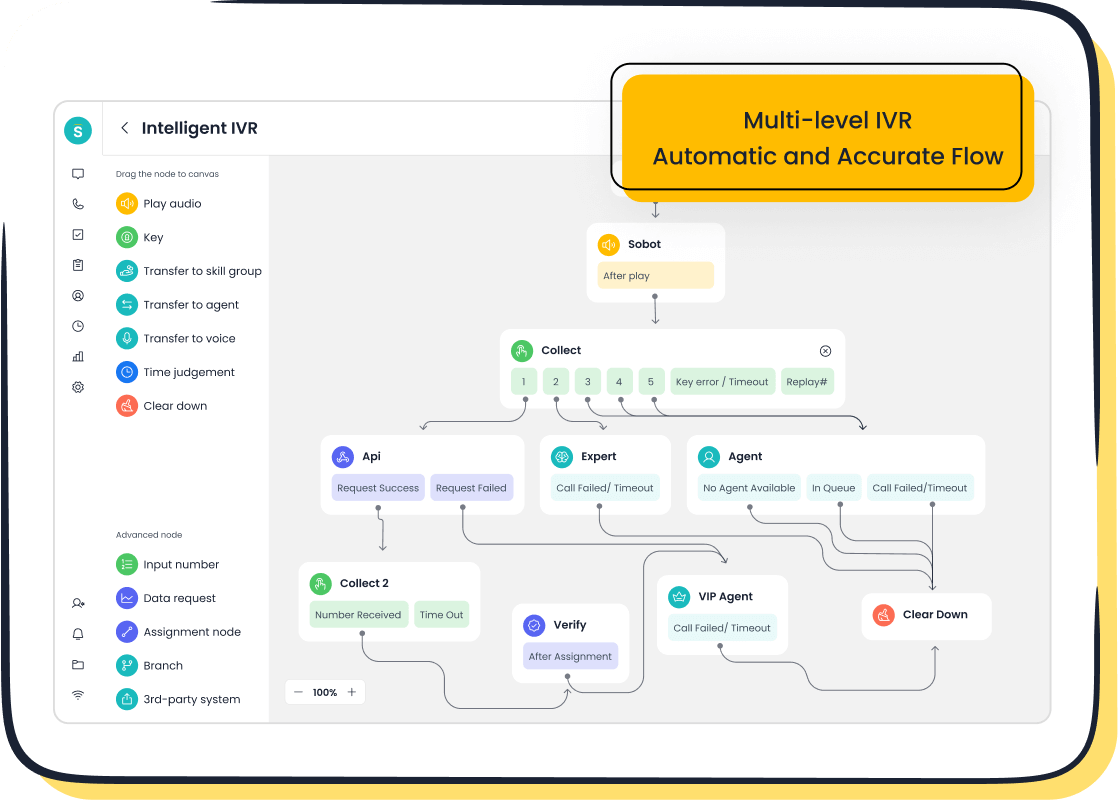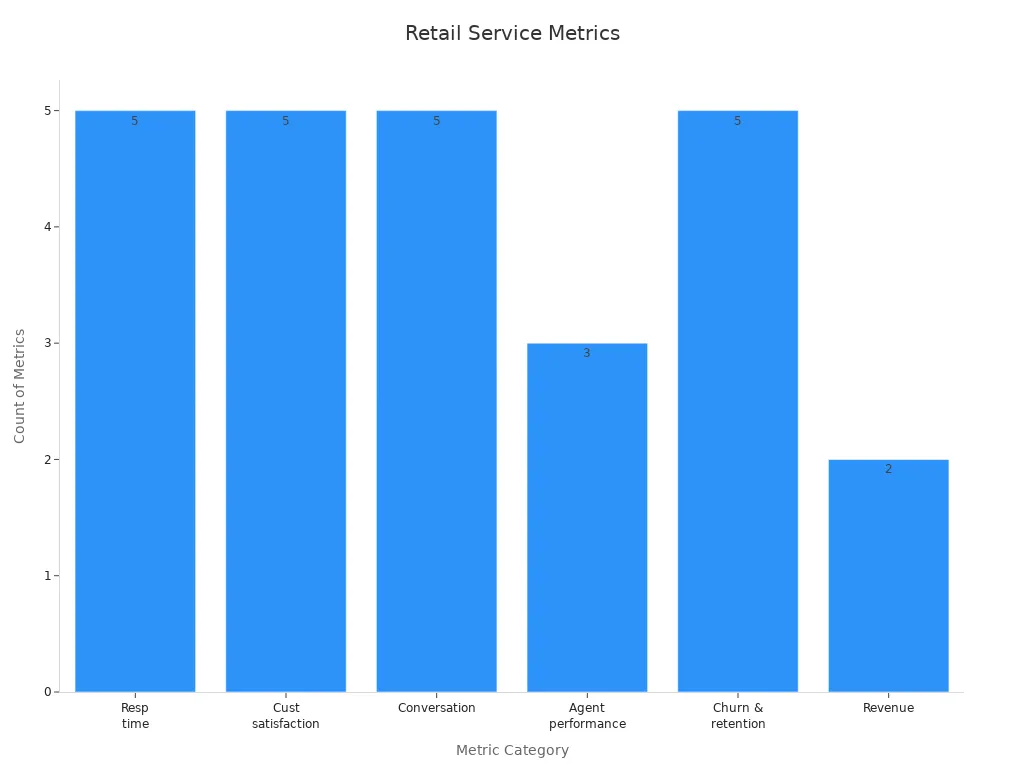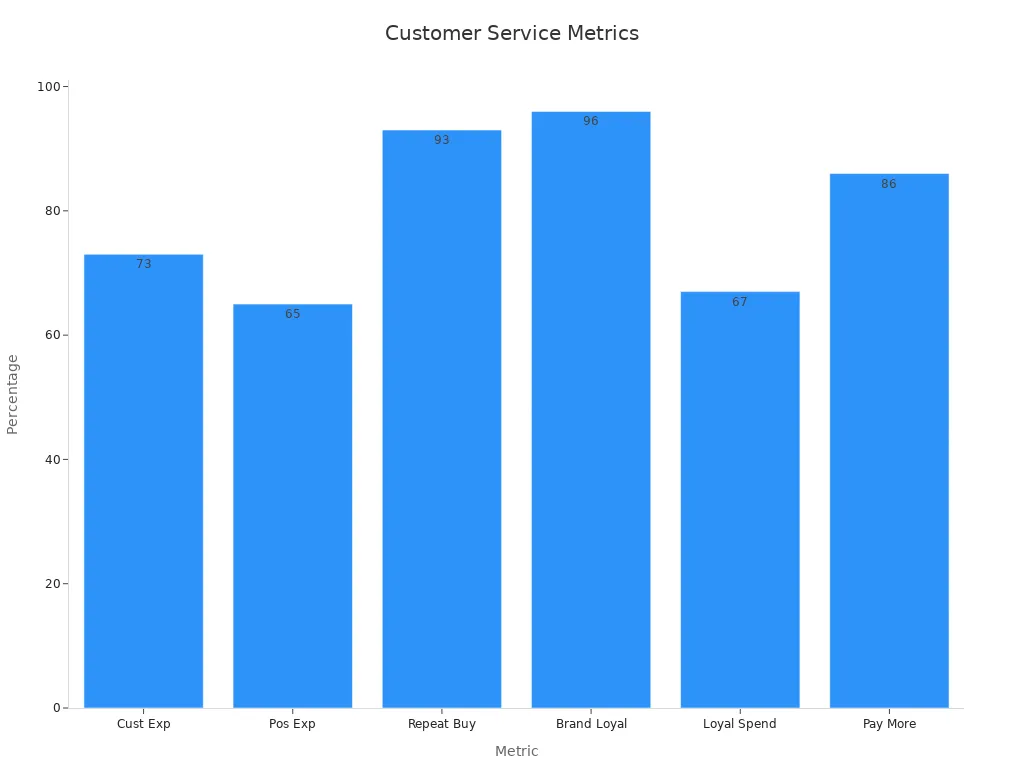Improve Retail Customer Service with Core Skills

When it comes to winning customer loyalty, great customer service in retail is the secret weapon. Think about it—how often do you return to a store because a staff member made your experience smooth and enjoyable? Studies show that businesses providing personalized experiences see a 70% jump in customer satisfaction. Plus, even a small 5% boost in customer retention can lead to a whopping 25% to 95% increase in profits. That’s the power of excellent service! Tools like Sobot’s omnichannel solutions help retailers create seamless experiences, making every customer interaction memorable and efficient.
Understanding Customer Service in Retail
Defining Retail Customer Service
Retail customer service is all about helping shoppers meet their needs and making their experience as smooth as possible. It includes everything from answering questions to offering perks like free shipping, loyalty rewards, or hassle-free returns. Think of it as the bridge between your store and your customers’ satisfaction. When you provide great customer service in retail, you’re not just solving problems—you’re building trust. Did you know that 88% of customers are more likely to buy again if they’ve had a positive service experience? That’s how powerful retail customer service can be.
At its core, customer service in retail is about support. Whether it’s before or after a purchase, your role is to ensure customers feel valued and understood. This could mean guiding them to the right product or addressing concerns after a sale. Every interaction counts, and each one is an opportunity to create a loyal customer.
Key Components of Excellent Customer Service
What makes customer service stand out? It’s often the little things that leave a big impression. Here are some key components:
- Ambient Conditions: Ever noticed how lighting or music can set the mood in a store? These subtle details can make customers feel welcome and relaxed.
- Facility Design: A clean, organized layout makes shopping easier and more enjoyable. It also reflects the quality of your brand.
- Service Personnel Appearance: How your team presents themselves matters. Professional and approachable staff can elevate the entire shopping experience.
Research shows that first impressions are often shaped by these physical cues. A well-organized store creates a sense of trust, while a cluttered one might send the wrong message. Paying attention to these details can turn a casual shopper into a loyal customer.
The Role of Customer Service in Retail Success
Customer service isn’t just a nice-to-have—it’s a game-changer for your business. Companies like Walmart and Amazon have mastered this by using data to personalize experiences. For example:
| Retailer | Application of Data Analytics | Impact on Customer Service and Sales |
|---|---|---|
| Walmart | Inventory Management | Ensures product availability, enhancing customer satisfaction |
| Amazon | Personalized Marketing | Tailors recommendations, improving customer engagement |
| Target | Customer Insights | Understands preferences, leading to better service and increased sales |
By tailoring experiences, offering personalized recommendations, and sending targeted promotions, you can make customers feel valued. This approach doesn’t just boost satisfaction—it drives sales. Tools like Sobot’s omnichannel solutions can help you achieve this by unifying customer interactions across platforms, ensuring every touchpoint feels seamless and personal.
Customer Expectations and Trends in Retail
What Customers Expect from Retail Customer Service
Your customers expect more than just a transaction—they want an experience. Today, 91% of shoppers still do at least half of their shopping in physical stores, but they’re not just looking for products. They want to interact with knowledgeable staff, see and touch items, and enjoy a seamless shopping journey. However, frustrations arise when retail staff lack training or stores are understaffed. In fact, 64% of consumers cite poorly trained employees as a major issue, while 60% blame inadequate staffing for dissatisfaction.
To meet these expectations, focus on creating a customer-centric environment. Train your team to be proactive and approachable. Equip them with tools like Sobot’s omnichannel solutions, which unify customer interactions across platforms. This ensures your staff has the information they need to provide personalized and efficient service, leaving customers feeling valued.
Emerging Trends Shaping Retail Customer Service
Retail is evolving, and so are customer expectations. Here’s a snapshot of the trends shaping the industry:
| Trend | Statistic | Source |
|---|---|---|
| Omnichannel integration | 73% of customers use multiple channels during their shopping journey | Harvard Business Review, 2022 |
| Hyper-personalization | Personalized marketing delivers 5-8 times the ROI on marketing spend | McKinsey, 2021 |
| Convenience supremacy | 83% of shoppers prioritize convenience more than five years ago | NRF, 2022 |
| Experiential shopping | 74% of Americans prefer experiences over products | Harris Poll, 2021 |
| Ethical consumption | 77% say sustainability impacts purchasing decisions | IBM, 2022 |
| BOPIS growth | BOPIS grew by 208% during the pandemic, remaining 20% above pre-pandemic levels | Adobe Digital Economy Index, 2022 |
These trends highlight the importance of convenience, personalization, and sustainability. For example, offering Buy Online, Pick Up In-Store (BOPIS) options can cater to convenience-focused shoppers. Similarly, integrating AI tools like Sobot’s Voice/Call Center can help you deliver hyper-personalized experiences by analyzing customer data and tailoring interactions.
The Role of Technology in Meeting Customer Expectations
Technology is a game-changer in retail customer service. Customers now expect faster responses, seamless interactions, and personalized recommendations. Did you know that 80% of consumers feel a company’s experience is essential to their loyalty? Or that 46% want replies faster than four hours? These numbers show how critical it is to leverage technology.


Sobot’s AI-powered solutions, like its Voice/Call Center, can help you meet these demands. Features like intelligent IVR and smart call routing ensure quick resolutions, while AI-driven insights enable personalized interactions. By adopting such tools, you can enhance the customer experience, reduce response times, and build lasting loyalty.
Essential Retail Customer Service Skills

Mastering essential retail customer service skills is the key to creating memorable customer experiences. These skills not only help you meet customer expectations but also build trust and loyalty. Let’s dive into the core customer service skills that every retail professional should develop.
Communication Skills for Clear and Effective Interactions
Clear communication is the backbone of effective customer service. When you interact with customers, your ability to convey information clearly and listen actively can make or break their experience. Imagine walking into a store and asking for help, only to receive vague or confusing answers. Frustrating, right? That’s why effective communication skills are non-negotiable.
Here’s why communication matters:
- 90% of Americans consider customer service a key factor in their business decisions.
- Customers are willing to spend 17% more on businesses that provide excellent service.
To excel in retail customer service, focus on active listening. Pay attention to what customers say and ask clarifying questions when needed. Use positive language to create a welcoming atmosphere. For example, instead of saying, “We don’t have that product,” try, “Let me check if we can order it for you.” Tools like Sobot’s Voice/Call Center can enhance communication by providing agents with customer data and insights, enabling more personalized and efficient interactions.
Empathy and Emotional Intelligence in Customer Service
Empathy and emotional intelligence are the heart of effective customer service. When you understand and connect with your customers’ emotions, you create a sense of trust and loyalty. Did you know that 95% of purchasing decisions are driven by emotions rather than logic? This highlights the importance of being emotionally attuned to your customers.
Here’s how empathy and emotional intelligence make a difference:
- Emotionally intelligent service enhances the overall customer experience, leading to increased loyalty.
- Salespeople with high emotional intelligence can build trust by understanding clients’ needs and emotions.
For example, if a customer is upset about a delayed order, responding with empathy can turn the situation around. Instead of just offering a solution, acknowledge their frustration by saying, “I understand how inconvenient this must be for you. Let me fix this right away.” Sobot’s AI-powered solutions, like its Voice/Call Center, can assist by analyzing customer sentiment and providing agents with real-time insights to tailor their responses.
Problem-Solving and Adaptability for Challenging Scenarios
In retail, challenges are inevitable. Whether it’s handling a product complaint or managing a long queue, your problem-solving skills and adaptability are crucial. Customers value immediate resolution, and your ability to think on your feet can leave a lasting impression.
Here’s why problem-solving matters:
- 76% of customers expect companies to understand their needs, but only 34% feel retailers meet these expectations well.
- Quick and effective solutions can turn a negative experience into a positive one.
To improve your problem-solving skills, practice staying calm under pressure. Break down the issue into smaller parts and address each one systematically. For instance, if a customer receives a damaged product, offer a replacement or refund promptly. Adaptability also plays a role. Be ready to adjust your approach based on the situation. Sobot’s omnichannel solutions can support you by unifying customer interactions, ensuring you have all the information needed to resolve issues efficiently.
Product Knowledge as a Foundation for Excellent Service
When it comes to retail customer service, knowing your products inside and out is a game-changer. Imagine walking into a store and asking about a product, only to get a vague or incorrect answer. Frustrating, right? That’s why product knowledge is so important. It’s not just about memorizing features—it’s about understanding how those features solve problems for your customers.
Deep product knowledge builds trust. When you confidently explain how a product works or why it’s the best choice, customers feel reassured. They’re more likely to buy and even recommend your store to others. In fact, 81% of consumers say their loyalty to a brand depends on the quality of customer service they receive. And nothing screams quality like a well-informed team.
Here’s how product knowledge impacts key performance metrics:
| Metric | Description |
|---|---|
| Customer Satisfaction Score (CSAT) | Measures how happy customers are with the product and the support they receive. |
| Net Promoter Score (NPS) | Reflects how likely customers are to recommend your store or products to others. |
| First Contact Resolution Rate | Shows how often issues are resolved in the first interaction, thanks to strong product knowledge. |
| Average Handle Time | Tracks how quickly customer interactions are completed, which improves with better knowledge. |
For example, let’s say a customer is unsure about which laptop to buy. If you can explain the differences between models and recommend one based on their needs, you’re not just making a sale—you’re creating a loyal customer. Tools like Sobot’s Voice/Call Center can help by giving your team instant access to product details and customer history. This ensures every interaction is accurate and efficient.
Pro Tip: Regular training sessions and workshops can keep your team’s product knowledge sharp. Pair this with Sobot’s unified workspace, and you’ll have all the information you need at your fingertips.
Time Management and Multitasking in Retail Environments
Retail environments can get hectic, especially during peak hours. You’ve got customers asking questions, inventory to manage, and maybe even a line at the register. That’s where time management and multitasking come into play. Mastering these skills helps you stay organized and ensures every customer gets the attention they deserve.
Here’s why time management matters: It keeps you focused on what’s important. Instead of feeling overwhelmed, you can prioritize tasks and handle them one at a time. For instance, if you’re helping a customer choose a product, you can use tools like Sobot’s AI-powered Voicebot to handle incoming calls or FAQs. This way, you’re not juggling too much at once.
Multitasking, on the other hand, is about efficiency. It’s not about doing everything at the same time—it’s about switching between tasks seamlessly. For example, while processing a return, you could also answer a quick question from another customer. The key is to stay calm and focused.
Here are some tips to improve these skills:
- Use Technology: Tools like Sobot’s omnichannel solutions can streamline your workflow by consolidating customer interactions in one place.
- Set Priorities: Focus on tasks that directly impact the customer experience, like resolving complaints or answering questions.
- Stay Organized: Keep your workspace tidy and use checklists to track your progress.
By managing your time well and multitasking effectively, you can handle busy days with ease. Customers will notice your efficiency, and that leaves a lasting impression. After all, a smooth shopping experience is what keeps them coming back.
Did You Know? Retailers using AI tools like Sobot’s solutions report a 30% boost in productivity. That’s because these tools handle repetitive tasks, giving you more time to focus on customers.
Strategies to Develop Core Retail Customer Service Skills
Developing core retail customer service skills is essential for creating exceptional customer experiences. With the right strategies, you can empower your team to handle challenges, connect with customers, and drive business success. Let’s explore some effective ways to build these skills.
Training Programs and Workshops for Skill Building
Investing in service training programs and workshops is one of the most effective ways to enhance your team’s skills. These programs provide structured learning opportunities, helping your staff master essential customer service techniques. They also ensure your team stays updated on the latest trends and technologies in retail.
Here’s why training matters:
- 73% of buyers say customer service influences their purchasing decisions.
- 43% of customers are willing to pay extra for convenience.
- 42% of shoppers value friendly interactions enough to pay more for them.
Training programs don’t just improve customer experiences. They also prepare your team to handle new tools and technologies, reduce operational losses, and maintain consistent brand representation. Plus, they boost employee retention by making your staff feel valued and equipped for success.
For example, a successful retail customer service training program might include sessions on active listening, empathy, and problem-solving. Pair these with hands-on workshops to reinforce learning. Tools like Sobot’s Voice/Call Center can complement these efforts by providing real-time insights and analytics, helping your team apply their skills effectively.
Pro Tip: Regularly schedule workshops to keep your team’s skills sharp and aligned with evolving customer expectations.
Role-Playing and Scenario-Based Practice
Role-playing and scenario-based practice are powerful tools for building confidence and refining customer service skills. These methods allow your team to simulate real-world situations in a controlled environment, making it easier to learn and adapt.
Here’s how they help:
- Build confidence in handling diverse customer issues.
- Enhance interpersonal and communication skills.
- Provide a safe space to make mistakes and learn from them.
- Accelerate time-to-proficiency for new hires.
- Improve understanding of customer needs and perspectives.
For instance, a role-playing exercise might involve upselling at a retail electronics store. The objective could be to develop skills in upselling while ensuring customer satisfaction. This practice hones communication, product knowledge, and the ability to address customer concerns effectively.
| Scenario | Objective | Skills Developed |
|---|---|---|
| Upselling at a Retail Electronics Store | Develop skills in upselling and enhancing customer satisfaction. | Effective communication, product knowledge, upselling techniques, handling customer concerns |
By practicing these scenarios, your team can improve their time-to-resolution and efficiency during real customer interactions. Sobot’s omnichannel solutions can further enhance this process by providing a unified workspace where agents can access customer data and insights, making their responses more accurate and personalized.
Did You Know? Role-playing exercises can reduce the time it takes for new agents to become proficient, ensuring they’re ready to deliver excellent service faster.
Leveraging Technology Like Sobot's Voice/Call Center for Training
Technology plays a crucial role in modern customer service training. Tools like Sobot’s Voice/Call Center offer innovative ways to train your team, ensuring they’re prepared to meet customer expectations.
Here’s how Sobot’s solutions can enhance training:
- Real-Time Monitoring: Supervisors can listen to live calls and provide immediate feedback, helping agents improve their communication skills.
- Call Analytics: Detailed insights into call data allow you to identify areas for improvement and tailor training sessions accordingly.
- AI-Powered Voicebot: This feature simulates customer interactions, giving your team a chance to practice handling various scenarios.
- Unified Workspace: Agents can access customer information and call history in one place, making it easier to learn and apply their skills.
For example, you can use Sobot’s intelligent IVR system to create training scenarios that mimic real customer inquiries. This hands-on approach helps your team develop problem-solving skills and adaptability. Additionally, the platform’s global number availability and time zone support ensure your team can practice serving customers from different regions, preparing them for diverse interactions.
By integrating technology into your training programs, you can create a more engaging and effective learning experience. This not only improves your team’s performance but also enhances customer satisfaction.
Pro Tip: Use Sobot’s analytics to track your team’s progress and identify skill gaps. This data-driven approach ensures your training efforts are always targeted and effective.
Encouraging Peer Feedback and Mentorship
Peer feedback and mentorship can transform your retail customer service team into a powerhouse of skills and confidence. When team members share insights and learn from each other, they grow faster and perform better. Mentorship, in particular, creates a ripple effect of improvement. It’s not just about teaching—it’s about building a culture where everyone feels supported and valued.
Why does this work so well? Let’s look at some real-world examples:
- IBM saw a 30% increase in promotion rates for employees with mentors compared to those without.
- General Electric reported that teams with active mentors outperformed others by 15% in completing projects.
- Johnson & Johnson’s mentorship program boosted employee satisfaction and engagement by 30%.
- Deloitte reduced employee turnover by 25% through mentorship initiatives.
These numbers show how impactful mentorship can be. In retail, this translates to better customer interactions, faster problem-solving, and higher satisfaction rates. Imagine a new hire learning the ropes from a seasoned team member. They pick up tips on handling tricky customer situations, managing time effectively, and even upselling products. This hands-on guidance builds confidence and ensures consistent service quality.
Peer feedback is equally powerful. It creates a loop of continuous improvement. For example, after a busy day, your team could hold a quick debrief. They can share what worked, what didn’t, and how to improve. This open dialogue fosters trust and collaboration. Plus, it helps everyone stay aligned with customer expectations.
Tools like Sobot’s Voice/Call Center can make this process even smoother. With features like call recording and analytics, your team can review real interactions and provide constructive feedback. This not only sharpens their skills but also ensures they’re always meeting customer needs. For instance, if a call reveals a gap in product knowledge, the team can address it immediately, ensuring better service in the future.
Pro Tip: Pair new hires with mentors during their first few weeks. This accelerates their learning curve and helps them feel more connected to the team.
Mentorship and feedback aren’t just about improving skills—they’re about creating a supportive environment. When your team feels valued, they’re more engaged and motivated. And that energy translates directly to your customers. A happy, confident team delivers exceptional retail customer service, every single time.
Did You Know? Retailers who invest in mentorship and feedback programs often see a boost in employee retention and customer satisfaction. It’s a win-win for everyone involved.
Implementing Retail Customer Service Skills in the Workplace
Building a Customer-Centric Culture
Creating a customer-centric culture transforms your retail environment into a space where shoppers feel valued and understood. It’s not just about policies—it’s about mindset. When you prioritize customer experience, every decision revolves around how it impacts your shoppers. This approach ensures your team consistently delivers high-quality service.
Here’s how you can build this culture:
- Make sure every employee understands their role in customer satisfaction. When your team knows their actions directly affect the customer experience, they’ll approach interactions with care and professionalism.
- Evaluate decisions through the lens of customer impact. Whether it’s store layout or return policies, always ask, “How does this benefit the customer?”
- Encourage employees to engage with customers. Empathy grows when your team connects with shoppers, making service delivery more personal and effective.
A customer-centric culture doesn’t just improve service—it boosts loyalty. Tools like Sobot’s omnichannel solutions unify customer interactions, helping your team deliver seamless experiences that align with this mindset.
Engaging Employees Through Recognition and Support
Your employees are the backbone of retail customer service. When they feel appreciated and supported, their performance improves. Recognition isn’t just a pat on the back—it’s a motivator that drives engagement and loyalty.
Here’s how you can engage your team:
- Celebrate achievements, big or small. Did someone resolve a tricky customer issue? Acknowledge it publicly.
- Provide resources for growth. Training programs and tools like Sobot’s Voice/Call Center empower your team to handle challenges confidently.
- Offer emotional support during busy periods. A simple “You’re doing great” can go a long way in boosting morale.
When employees feel valued, they’re more likely to go the extra mile for customers. This creates a ripple effect—happy employees lead to happy customers, and that’s the foundation of great retail customer service.
Real-World Examples of Skill Application
Sometimes, the best lessons come from real-world stories. Here are a few examples of how retail customer service skills make a difference:
- At an appliance store, a representative helped a shopper save $700 by recommending a previous year’s model with similar features. The customer was so impressed, they made additional purchases.
- eShakti’s team created a custom clothing item for a wedding, ensuring it arrived on time. This thoughtful gesture turned a stressful situation into a memorable experience.
- A FedEx representative educated a customer on delivery options during a long hold time. Despite the delay, the customer left with a positive impression.
These stories highlight the power of empathy, problem-solving, and product knowledge. With tools like Sobot’s Voice/Call Center, your team can access customer data instantly, enabling them to deliver personalized solutions that leave lasting impressions.
Overcoming Challenges in Skill Implementation
Implementing customer service skills in retail isn’t always smooth sailing. You might face obstacles that slow progress or create confusion among your team. Tackling these challenges head-on ensures your efforts lead to better customer experiences and stronger business outcomes.
Here are some common hurdles you might encounter:
- Unclear Objectives: Without clear goals, your team may struggle to understand what’s expected. Define specific, measurable objectives like improving first-contact resolution rates or boosting customer satisfaction scores.
- User Adoption Issues: Resistance to change can make it hard to introduce new tools or systems. Comprehensive training and ongoing support help your team adapt. For example, Sobot’s Voice/Call Center simplifies adoption with its intuitive interface and seamless integration.
- Ignoring Customer Feedback: Skipping feedback analysis can lead to missed opportunities for improvement. Regularly gather and review customer insights to identify gaps in service and refine your approach.
Let’s say your team hesitates to use a new CRM system. This resistance might stem from unfamiliarity or fear of making mistakes. You can address this by offering hands-on training sessions and pairing employees with mentors. Tools like Sobot’s unified workspace make the transition easier by consolidating customer data, so your team feels confident and prepared.
Another challenge is maintaining consistency across channels. Customers expect the same level of service whether they’re shopping online or in-store. Sobot’s omnichannel solutions unify interactions, ensuring your team delivers seamless experiences every time.
Pro Tip: Use analytics to track progress and pinpoint areas for improvement. For instance, Sobot’s call tracking feature provides actionable insights, helping you refine your strategies and overcome obstacles effectively.
By addressing these challenges, you’ll empower your team to implement customer service skills successfully. This leads to happier customers, stronger loyalty, and a thriving retail business.
Measuring Success in Retail Customer Service

Using Customer Feedback to Evaluate Performance
Customer feedback is like a compass—it shows you where you're excelling and where you need to improve. Listening to your customers helps you understand their needs and expectations, which is key to achieving service excellence. But how do you gather this feedback effectively? Here are some tried-and-true methods:
- Use customer satisfaction (CSAT) surveys to measure how happy your customers are with your service. These surveys can pinpoint areas that need attention.
- Leverage Net Promoter Score (NPS) to gauge loyalty. Ask customers how likely they are to recommend your store to others. A high NPS means you're on the right track.
- Analyze survey data to uncover trends. This helps you make informed decisions to enhance customer satisfaction.
For example, if your NPS reveals that customers love your product selection but dislike long wait times, you can focus on improving checkout efficiency. Tools like Sobot’s Voice/Call Center can simplify this process by collecting and analyzing feedback, giving you actionable insights to refine your service.
Tracking Key Metrics for Retail Customer Service
Metrics are the heartbeat of service excellence. They help you measure performance and identify opportunities for growth. Here’s a breakdown of key metrics you should track:
| Metric Category | Key Metrics |
|---|---|
| Response time metrics | First response time, Average resolution time, First call resolution |
| Customer satisfaction metrics | CSAT, Customer effort score (CES), NPS |
| Conversation metrics | Abandoned conversation rate, Self-service resolution rate |
| Agent performance metrics | Tickets closed per agent, Ticket quality |
| Churn & retention metrics | Repeat customer rate, Customer retention rate |

Tracking these metrics ensures you’re not just meeting expectations but exceeding them. For instance, monitoring first response time can help you reduce delays, while analyzing CSAT scores can highlight areas for improvement. Sobot’s omnichannel solutions make it easy to track these metrics in real-time, ensuring you stay ahead of the curve.
Continuous Improvement Through Regular Assessments
Service excellence isn’t a one-time achievement—it’s an ongoing journey. Regular assessments help you maintain high standards and adapt to changing customer needs. Here’s why continuous improvement matters:
- 85% of consumers are more likely to repurchase after a positive experience. Regular evaluations ensure you’re consistently delivering that experience.
- Companies that invest in employee development and self-awareness create better customer interactions.
Start by conducting quarterly reviews of your service metrics. Use tools like Sobot’s Voice/Call Center to analyze call data and identify trends. Encourage your team to participate in these assessments. Their insights can reveal hidden challenges and opportunities. For example, if agents report frequent questions about a specific product, you can update your knowledge base to address this.
Continuous improvement isn’t just about fixing problems—it’s about staying proactive. By fostering a culture of growth, you’ll not only boost customer satisfaction but also build loyalty that lasts.
Mastering retail customer service skills isn’t just a short-term win—it’s the foundation for long-term success. When you prioritize customer experience, you build trust, foster customer loyalty, and drive repeat business. Statistics show that 93% of customers are likely to make repeat purchases when they receive excellent service, and loyal customers spend 67% more than new ones. These numbers highlight the financial and relational benefits of great service.
Tools like Sobot’s Voice/Call Center amplify these efforts by streamlining customer interactions. Features like intelligent IVR and AI-powered Voicebot reduce inbound discussion volume by 20%, while autonomous responses answer 22.2% of customer questions. This leads to a CSAT score of 97% and 99% customer satisfaction. By leveraging such technology, you can deliver faster resolutions and personalized experiences that keep customers coming back.
Continuous learning is key to staying ahead of evolving expectations. Invest in training, embrace new tools, and adapt to trends. When you combine skilled employees with innovative solutions, you create a retail environment that thrives on exceptional service.

FAQ
What is the most important skill for retail customer service?
Empathy is key. When you understand your customers' feelings, you can connect with them better. For example, if a shopper is frustrated about a delayed order, showing empathy can turn their experience around. Tools like Sobot’s Voice/Call Center help by analyzing customer sentiment for tailored responses.
How can technology improve retail customer service?
Technology speeds up responses and personalizes interactions. For instance, Sobot’s AI-powered Voicebot handles repetitive queries, freeing your team to focus on complex issues. This reduces response times and boosts customer satisfaction. Did you know 80% of customers expect faster replies? That’s where tech shines!
Why is product knowledge essential in retail?
Knowing your products builds trust. Imagine asking about a product and getting a vague answer—it’s frustrating, right? With tools like Sobot’s unified workspace, your team can access product details instantly, ensuring accurate and confident responses. This improves customer satisfaction and loyalty.
How do you measure success in retail customer service?
Track metrics like CSAT, NPS, and first response time. For example, Sobot’s omnichannel solutions provide real-time analytics, helping you identify areas for improvement. High CSAT scores mean happy customers, while a low first response time shows efficiency. These metrics guide your service strategy.
What are some tips for handling challenging customer scenarios?
Stay calm and listen actively. Break the problem into smaller parts and address each one. For example, if a customer receives a damaged product, offer a replacement quickly. Sobot’s omnichannel solutions unify customer data, making it easier to resolve issues efficiently and leave a positive impression.
See Also
Excelling at Live Chat Within the Retail Sector
Enhancing Live Chat Effectiveness in Retail Business
Ten Strategies to Improve Customer Satisfaction via Live Chat
